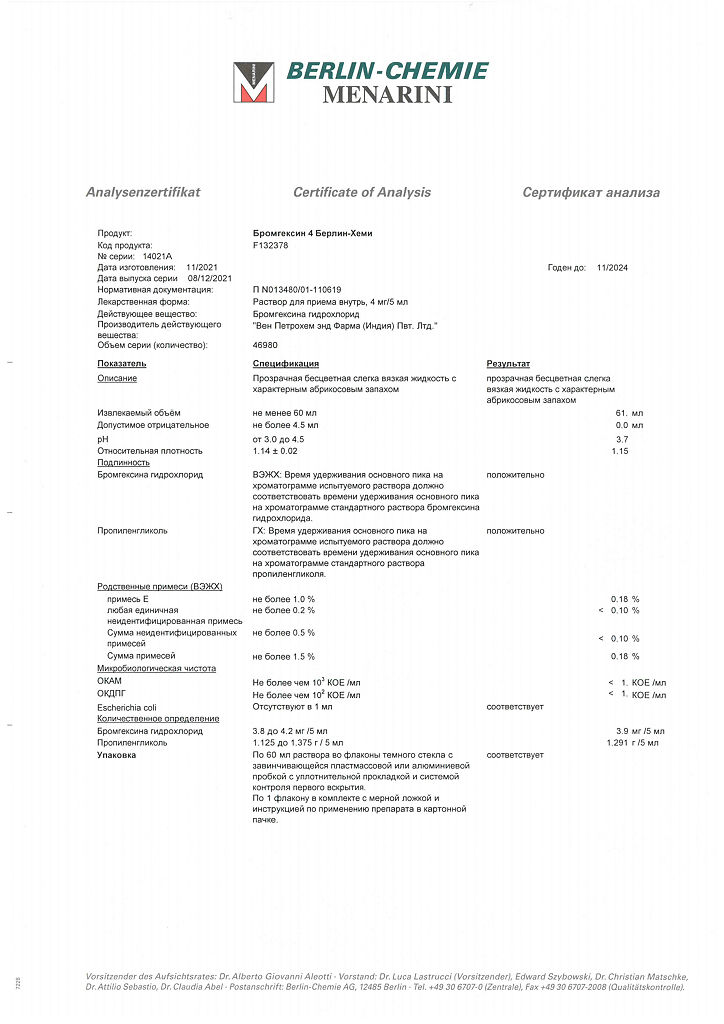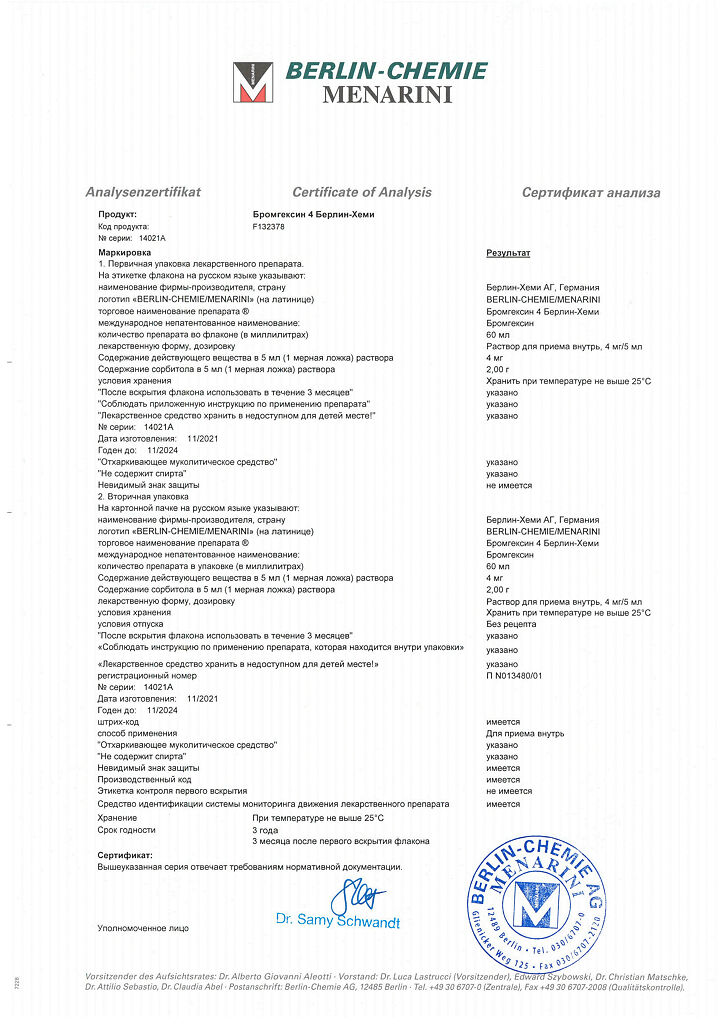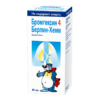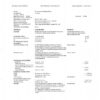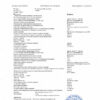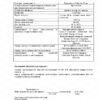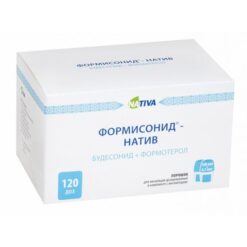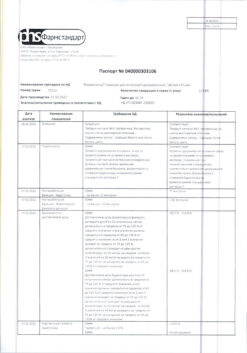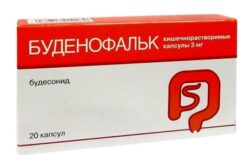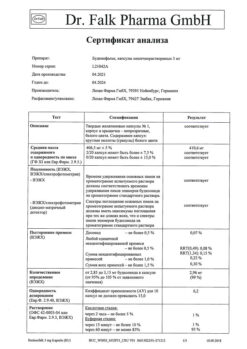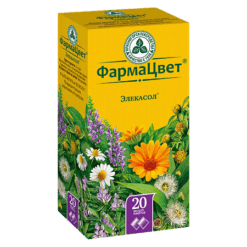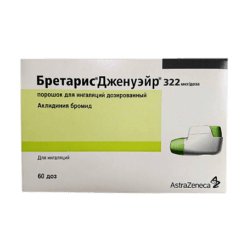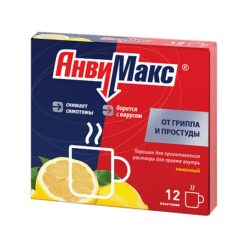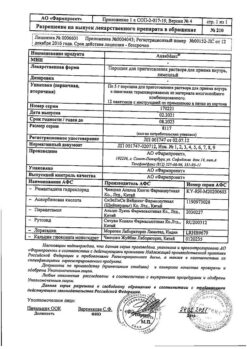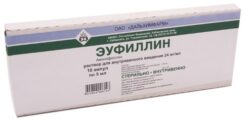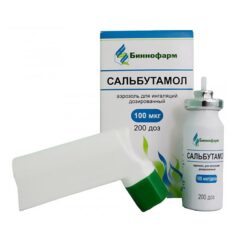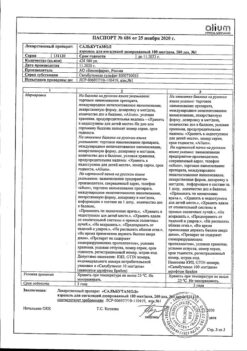No products in the cart.
Bromhexin 4 Berlin-Chemie, 4 mg/5 ml 60 ml
€8.91 €7.42
Description
Pharmacotherapeutic group: expectorant mucolytic agent
ATC code: R05CB02
Pharmacological properties
Pharmacodynamics<
Bromhexin has mucolytic (secretolytic) and expectorant (secretomotor) effects. It reduces the viscosity of sputum; it activates the permeable epithelium, increases the volume of sputum and improves its discharge. Stimulates production of endogenous surfactant, which provides stability of alveolar cells during breathing. The effect is seen 2-5 days after the start of treatment.
Pharmacokinetics
absorption. After oral administration, bromhexine is rapidly and almost completely absorbed from the gastrointestinal tract. Half-absorption period is about 0.4 h. Maximum concentration in blood plasma after oral administration is reached after 1 hour.
Distribution The volume of distribution is approximately 7 l/kg body weight. The degree of binding to plasma proteins is 99%. Bromhexin penetrates the blood-brain barrier and the placental barrier. It penetrates into breast milk and cerebrospinal fluid. Bromhexin does not undergo cumulation.
Metabolism.80% of bromhexine undergoes a “first pass” effect through the liver to form biologically active metabolites. In severe liver disease there is a decrease in clearance of bromhexine.
Elimation Bromhexine is excreted from the body mainly as metabolites. The half-life of reaching minimum effective concentration after reaching equilibrium between absorption and excretion is approximately 1 h. The final half-life is about 16 h due to reverse distribution of small amounts of bromhexine from tissues.
Extracted mainly by the kidneys as metabolites formed in the liver. Due to the high degree of binding to plasma proteins and high volume of distribution, as well as slow redistribution from tissues into blood, significant excretion of bromhexine by dialysis or forced diuresis is not expected.
In severe renal failure, an increase in the half-life of bromhexine metabolites cannot be excluded. Nitrosation of bromhexin under physiological conditions in the stomach is possible.
Indications
Indications
Secretolytic therapy for acute and chronic bronchopulmonary diseases associated with impaired secretion and transport of sputum (for example, acute and chronic bronchitis, bronchiectasis, tracheobronchitis, pneumonia, emphysema, cystic fibrosis, tuberculosis, pneumoconiosis).
Pharmacological effect
Pharmacological effect
Pharmacotherapeutic group: expectorant mucolytic agent
ATX code: R05CB02
Pharmacological properties
Pharmacodynamics
Bromhexine has a mucolytic (secretolytic) and expectorant (secretomotor) effect. Reduces the viscosity of sputum; activates the ciliated epithelium, increases the volume of sputum and improves its discharge. Stimulates the production of endogenous surfactant, which ensures the stability of alveolar cells during respiration. The effect appears within 2-5 days from the start of treatment.
Pharmacokinetics
Suction. After oral administration, bromhexine is quickly and almost completely absorbed from the gastrointestinal tract. The half-life of absorption is about 0.4 hours. The maximum concentration in the blood plasma after oral administration is reached after 1 hour.
Distribution. The volume of distribution is approximately 7 l/kg body weight. The degree of binding to plasma proteins is 99%. Bromhexine penetrates the blood-brain barrier and the placental barrier. Penetrates into breast milk and cerebrospinal fluid. Bromhexine does not accumulate.
Metabolism. 80% of bromhexine undergoes a “first pass” effect through the liver with the formation of biologically active metabolites. In severe liver diseases, a decrease in the clearance of bromhexine is observed.
Excretion. Bromhexine is excreted from the body mainly in the form of metabolites. The half-life to achieve the minimum effective concentration after achieving equilibrium between the processes of absorption and excretion is approximately 1 hour. The final half-life is approximately 16 hours due to the reverse distribution of small amounts of bromhexine from tissues.
It is excreted primarily by the kidneys in the form of metabolites formed in the liver. Due to the high degree of binding to plasma proteins and the high volume of distribution, as well as the slow redistribution from tissues to the blood, significant elimination of bromhexine by dialysis or forced diuresis should not be expected.
In severe renal failure, an increase in the half-life of bromhexine metabolites cannot be excluded. Nitrosation of bromhexine is possible under physiological conditions in the stomach.
Special instructions
Special instructions
In cases of impaired bronchial motility or with a significant volume of sputum secreted (for example, in the rare syndrome of primary ciliary dyskinesia), the use of Bromhexine 4 Berlin-Chemie requires caution due to the increased risk of airway obstruction.
In case of impaired renal function and severe liver disease, Bromhexine 4 Berlin-Chemie should be used with extreme caution (for example, it is recommended to reduce the dose or increase the intervals between doses). In severe renal failure, it is necessary to take into account the possibility of accumulation of metabolites formed in the liver.
Monitoring of liver function is recommended, especially during long-term treatment.
There is evidence of the occurrence in very rare cases of severe skin reactions (such as erythema multiforme, Stevens-Johnson syndrome, toxic epidermal necrolysis, acute generalized exanthematous pustulosis) while taking bromhexine.
If allergic reactions and/or signs of progressive skin rash occur (sometimes in combination with the appearance of blisters and damage to the mucous membranes), you should immediately stop using the drug and consult a doctor.
The use of Bromhexine 4 Berlin-Chemie in children over 2 years of age is possible only under the supervision of a physician.
Propylene glycol, which is part of the drug Bromhexine 4 Berlin-Chemie, can cause symptoms in children similar to those that occur after drinking alcohol.
Instructions for patients with diabetes: 5 ml of solution (1 scoop) contains 2 g of sorbitol (equivalent to 0.5 g of fructose), which corresponds to 0.17 bread units.
Sorbitol may have a slight laxative effect.
Effect of the drug on the ability to drive vehicles and machinery
When taken in recommended doses, Bromhexine 4 Berlin-Chemie does not affect the speed of psychomotor reactions.
Active ingredient
Active ingredient
Bromhexine
Composition
Composition
Composition per 100 ml solution:
Active ingredient: bromhexine hydrochloride – 0.08 g;
Excipients: propylene glycol, sorbitol, apricot-scented aromatic concentrate, hydrochloric acid 0.1 M (3.5%) solution, purified water.
Pregnancy
Pregnancy
The use of the drug in the first trimester of pregnancy is contraindicated. In the second and third trimesters of pregnancy, the use of the drug is possible only if the expected benefit to the mother outweighs the possible risk to the fetus. The use of the drug during breastfeeding is contraindicated.
Contraindications
Contraindications
hypersensitivity to bromhexine and other components of the drug;
peptic ulcer of the stomach and/or duodenum (including a history);
pregnancy (first trimester);
breastfeeding period;
children under 2 years of age;
congenital fructose intolerance.
With caution
renal and/or liver failure;
in case of impaired bronchial motility, accompanied by excessive accumulation of secretions;
children aged from 2 to 6 years (used as prescribed by a doctor).
Side Effects
Side Effects
Possible side effects are listed below in descending frequency of occurrence: very common (>1/10), common (>1/100, >1/10), uncommon (>1/1000, >1/100), rare (>1/10000, <1/1000), very rare, including isolated reports (<1/10000), frequency not established (cannot be estimated based on available data).
From the gastrointestinal tract
Uncommon: nausea, vomiting, diarrhea, abdominal pain;
From the immune system
Rarely: hypersensitivity reactions;
Frequency not established: anaphylactic reactions, including anaphylactic shock, angioedema, pruritus.
From the skin and subcutaneous tissues
Rarely: skin rash, urticaria;
Frequency not established: severe skin reactions, including erythema multiforme, Stevens-Johnson syndrome, toxic epidermal necrolysis (Lyell’s syndrome), acute generalized exanthematous pustulosis (see section “Special instructions”).
General violations
Uncommon: fever.
In case of all forms of allergic reactions (hypersensitivity, anaphylaxis) or in the event of any damage to the skin and/or mucous membranes, you must stop taking this drug and immediately inform your doctor.
Interaction
Interaction
Bromhexine 4 Berlin-Chemie can be prescribed simultaneously with other drugs used in the treatment of bronchopulmonary diseases.
Bromhexine is not prescribed simultaneously with antitussives (including those containing codeine), because due to the suppression of the reflex, the evacuation of liquefied sputum is difficult, which can lead to the accumulation of secretions in the respiratory tract.
Bromhexine 4 Berlin-Chemie promotes the penetration of antibiotics (erythromycin, cephalexin, oxytetracycline, ampicillin, amoxicillin) into bronchial secretions in the first 4-5 days of antimicrobial therapy. The clinical significance of this possible interaction has not been proven.
When used simultaneously with drugs that irritate the gastrointestinal tract (for example, some non-steroidal anti-inflammatory drugs), the irritant effect of the latter on the gastric mucosa may be increased.
Overdose
Overdose
Life-threatening symptoms of overdose with Bromhexine 4 Berlin-Chemie are unknown.
Symptoms: A study of overdose cases has been published, according to which vomiting was observed in 4 out of 25 overdose cases. Three children experienced vomiting, as well as stunned consciousness, ataxia, diplopia, mild metabolic acidosis, and tachypnea. In children, symptoms did not occur when taking bromhexine at doses up to 40 mg, even in the absence of treatment.
There is no evidence of chronic toxicity of bromhexine in humans.
Treatment: in case of severe overdose, monitoring of blood circulation and, if necessary, symptomatic treatment are indicated. Due to the low toxicity of bromhexine, as a rule, there is no need for invasive measures aimed at reducing its absorption (forced vomiting, gastric lavage) or accelerating excretion. In addition, due to the pharmacokinetics (high volume of distribution, slow redistribution processes and high degree of protein binding), effective removal of bromhexine from the body by dialysis or forced diuresis should not be expected.
Since in children over 2 years of age, even after taking large doses of bromhexine, only mild symptoms are expected, with a dose of bromhexine hydrochloride up to 80 mg (for example, 100 ml of Bromhexine 4 Berlin-Chemie), detoxification may not be necessary. In younger children, the appropriate dose limit is 60 mg bromhexine hydrochloride (6 mg/kg body weight).
In case of overdose, it is also possible to develop side effects caused by excipients.
Storage conditions
Storage conditions
At a temperature not higher than 25 oC.
Keep the medicine out of the reach of children!
Shelf life
Shelf life
3 years. 3 months – after the first opening of the bottle. Do not use after the expiration date stated on the package.
Organization receiving complaints from consumers:
LLC “Berlin-Chemie/A. Menarini”, Russia
123112, Moscow, Presnenskaya embankment, building 10, Business Center “Tower on the Embankment”, Block B, tel. (495) 785-01-00, fax (495) 785-01-01.
Manufacturer
Manufacturer
Berlin-Chemie AG, Germany
Additional information
| Shelf life | 3 years. 3 months – after the first opening of the bottle. Do not use after the expiration date stated on the package. An organization accepting claims from consumers: Loc. Menarini, Russia 123112, Moscow, Presnenskaya naberezhnaya, 10, BC "Bashnya na naberezhnoy", Block B, tel. (495) 785-01-00, fax (495) 785-01-01. |
|---|---|
| Conditions of storage | At a temperature not exceeding 25 oC. Keep the drug out of reach of children! |
| Manufacturer | Berlin-Chemie AG, Germany |
| Medication form | oral solution |
| Brand | Berlin-Chemie AG |
Related products
Buy Bromhexin 4 Berlin-Chemie, 4 mg/5 ml 60 ml with delivery to USA, UK, Europe and over 120 other countries.


